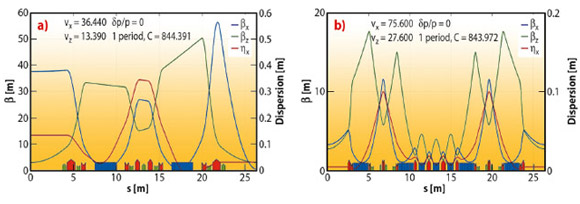- Home
- Users & Science
- Scientific Documentation
- ESRF Highlights
- ESRF Highlights 2012
- Accelerator and X-ray Source
- Low emittance project
Low emittance project
In the past year, the Accelerator and Source Division has finalised its project for the Accelerator Phase II Upgrade. The project aims to greatly improve the brightness of the source by decreasing the horizontal equilibrium emittance of the storage ring from the present 4 nm to 150 pm. This will be possible by replacing the present 32 double-bend achromat ARCs with a much more compact lattice based on hybrid 7-bend arc achromats (Figure 154). The smaller emittance, together with the development of shorter period smaller gap undulators and new beamline optics optimised to take full advantage of the new source, will allow a general improvement in performance by about a factor 100.
 |
|
Fig. 154: The hybrid multi-bend (HMB) lattice. a) Existing cell (DBA) with a vertical emittance of 4 nm.rad. b) Proposed HMB cell with a vertical emittance of 150 pm.rad. |
The scheme also provides the following advantages:
- the existing straight sections and beamlines can be maintained unchanged
- the present injection scheme and injection complex can be maintained unchanged
- the existing ARCs hardware can be reused (e.g. power supplies, vacuum system components, diagnostics, etc.)
- operation costs can be reduced, especially wall plug power
The technical aspects are challenging: very high gradient quadrupole magnets and tight tolerances are required. The vacuum system has to take full advantage of the new techniques developed in the last 10-20 years (e.g. NEG coating).
A white paper describing the general upgrade scheme and the science case has been submitted to the ESRF Council for approval of the technical design study phase, which is foreseen to be completed in two phases:
- Phase 1 at the end of 2014 to allow the beginning of the procurement phase
- Phase 2 at the end of 2016 to allow the beginning of the assembly phase
Installation is foreseen to start in the second half of 2018 and the user mode operations with the upgraded machine to be resumed in the second half of 2019.



